Canada Line Construction William Slim |

Vancouver British Columbia - Canada Line construction may have cored and split this city, driven businesses from the Cambie village, and made commuting a living hell, but Steve Crombie, vice-president of public affairs for InTransitBC, is anxious to show another side of the story.
Fourteen metres below ground at the bottom of a spiderweb of scaffolding, in the tunnel entry pit, is a small shrine.
A roughly constructed wooden box filled with faded plastic flowers and a statue of a saint sit crookedly on top of an electrical box. Saint Barbara, says Andrea Ciamei, project manager of tunneling, is the patron saint of miners.
"We bring her with us every place we go," says Ciamei in a heavy Italian accent.
Ciamei is in charge of a crew of about 50 so-called "tunnel rats," international workers who travel with him from country to country, job to job.
Their specialty is the dangerous work of building the tunnels many will use but few will ever see. Saint Barbara, says Ciamei, brings good luck, protection, and safety.
It's a small sign that something magic, something other than logic, precision, and expert engineering may be at work here.
Indeed, what is happening below the frustrating maze of fencing and Jersey barriers that keep our cars snarled up in traffic, is a tidy, clockwork operation.
At the entry pit, temporary track is already in place. Trains of coupled boxcars pull into circular tunnels. They carry precast cement segments; each train carries six sections that make one segment. Twenty-four hours a day, the trains move these segments into the earth.
As the Tunnel Boring Machine (TBM) pushes forward at the head of the tunnel, the muck, soil and water, is pushed out behind it onto a screw conveyer that brings it to a belt, and so out of the tunnel.
Approximately 75,000 cubic metres of muck has been removed so far. The precast segments are erected inside a metal shield which is then removed.
Forty-six metres below False Creek, the tunnel is clean and neat, a kind of peaceful place, wending unevenly below the waterway, following the natural curves of the earth.
The side-by-side tunnels have fire doors every 46 metres. In case of emergency, riders will be able to hop from a smoke-filled tunnel to a separately ventilated exit route.
Roger Woodhead, technical director and the engineer behind much of the construction, is obviously proud of how things are coming along. But, he admits with a laugh, "Sometimes I have nightmares about it."
Construction presented some special challenges. Bored tunnels must be deeper below ground, cut-and cover allows tunnels to be dug closer to the surface, he explains.
"People feel safer closer to the surface."
Around the waterways, archeological monitors had to be present to ensure no first nations sites were disturbed, they weren't, layers of "glacial till," dumped here millions of years ago, created a set of variable substances that had to be dealt with in different ways.
Farther up the line, in Richmond, where elevated guideways soar over the Arthur Laing Bridge, the engineering problems were different. Special piles with cement filled "bulbs" at their base were designed to withstand earthquake motion.
"The guideways may move in the event of an earthquake, but they won't fall over," says Woodhead. Another innovation is the cable-stayed bridge over the north arm of the Fraser River, the only bridge of its kind in North America.
"In order to build this bridge," explains Crombie, "we had to keep the towers low due to air traffic, and wide apart because it's an active waterway."
The solution was to design a unique span that uses both post tension and cables. But what Crombie and his team may be most proud of is that the controversial cut-and-cover construction on Cambie is months ahead of schedule.
The Cambie section's original completion date had been April 2008, that has now been pushed up to December.
"In and out in under a year," says Crombie. "Restoration has already begun."
It's good news for commuters and businesses along Cambie, and it's the kind of good news that matters to Crombie and his team who, like the rest of us, are still having a few problems getting to work each day.
Author unknown